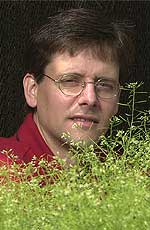West Lafayette, Indiana
October 31, 2005
A mutated plant that seems to
return from the dead may hold the secret to how some flora
protect their progeny during yield-limiting drought and other
stresses, according to Purdue
University scientists whose study of the plant led to
discovery of a gene.
 |
|
A mutant Arabidopsis
that seemed to rise from the dead helped Purdue plant
physiologist Matthew Jenks and his research team find a
genetic connection between lipid synthesis and embryo
development in plants. The abnormal plant helped them
discover a new gene they dubbed Resurrection that
apparently plays a part in lipid signaling of seed
abortion. (Purdue Agricultural Communications
photo/Tom Campbell) |
The gene, called RESURRECTION1
(RST1), has revealed a previously unknown genetic connection
between lipid development and embryo development in plants, said
Matthew Jenks (photo), lead author of the study and a Purdue
plant physiologist.
Lipids play a role in preventing plant dehydration in forming
cells' membranes, in molecular signaling and in energy storage.
A still-to-be revealed lipid associated with formation of the
cuticle that coats plant surfaces may signal whether a seed
develops to maturity or is aborted early due to a defective
embryo.
"This is interesting because in crop production a number of
plants have a problem of reduced yield due to seed or fruit
abortion," Jenks said. "It's thought that plants may abort some
of their seeds, especially under stress, to conserve and divert
resources to the remaining seeds. So, in a drought situation,
for example, plants will get rid of some seeds so that they can
support growth of at least a few healthy seeds."
In the November issue of Plant Physiology, Jenks and his team of
researchers from the Purdue Department of Horticulture and
Landscape Architecture report on the normal gene RST1.
They found the gene while studying a unique surface wax mutant
of Arabidopsis, a common laboratory research plant. All plants
have a certain amount of wax overlaying leaves and stems.
The abnormal plant, a mutant of RST1, had short, rounded leaves
that turned purple during development, and then before
flowering, the plant quickly browned and looked dead. It also
had a large proportion of small, wrinkled, non-viable seeds with
aborted embryos. These contained only 34 percent of the normal
amount of lipids.
"It appeared to have died, and I left it in a room for two or
three weeks. I was just slow in throwing it away," said Jenks,
who also is a member of the Purdue Center for Plant
Environmental Stress Physiology. "When I went to throw it away,
I noticed it had small shoots coming up as if it had returned to
life."
The surprising finding in studying the mutant was that a single
gene could affect so many diverse traits, Jenks said. Another
somewhat similar mutant Arabidopsis showed alterations only in
wax and seed development, but not in the other mutated RST1
traits. This was a major clue that changes in lipid synthesis
were somehow altering seed development.
Scientists already know that lipids play an important role in
signaling developmental changes in plants and animals, and that
other plants and animals, including humans, have genes similar
to RST1. Jenks and his team now want to determine the exact role
of RST1 in lipid signaling that affects plant development,
particularly its role in crop seed self-thinning mechanisms
through embryo abortion.
Unlike some other mutants that abort all of its seeds, the
mutant RST1 plant aborts only about 70 percent of the seeds, he
said.
"RST1 is not required for seed development, but it does
influence how seeds develop, perhaps playing a role in
regulating the number of seeds a plant will support to
maturity," Jenks said. "Seed abortion by plants likely is a
tightly regulated process that necessitates allowing some seed
loss to conserve resources in a stressful environment without
aborting all seeds, which would leave the plant with no healthy
offspring."
If researchers learn how to control plant embryo abortion, they
may be able to increase yield by helping plants shed fewer
seeds, grains or fruits, especially under drought conditions and
in other stressful environments.
U.S. Department of Agriculture National Research Initiative and
the SALK Institute Genomic Analysis Laboratory provided support
for this work.
The other researchers involved in the study were Ray Bressan,
Purdue Department of Horticulture and Landscape Architecture
professor; Xinbo Chen, Xionglun Liu and Xinlu Chen, all
horticulture postdoctoral students; and S. Mark Goodwin, a
horticulture doctoral student.
Related Web sites:
- Purdue Department of Horticulture and Landscape Architecture:
http://www.hort.purdue.edu/hort/default.shtml
- Plant Physiology:
http://www.plantphysiol.org/
- Center for Plant Environmental Stress Physiology:
http://www.hort.purdue.edu/cfpesp/
- U.S. Department of Agriculture/National Research Initiative:
http://www.csrees.usda.gov/fo/fundview.cfmfonum=1112
- Salk Institute:
http://www.salk.edu/
The paper is currently published in the online version of
Plant Physiology and
scheduled for the journal's November issue.
Writer: Susan A. Steeves, (765)
496-7481,
ssteeves@purdue.edu
Source: Matthew Jenks, (765) 494-1332,
jenksm@purdue.edu |